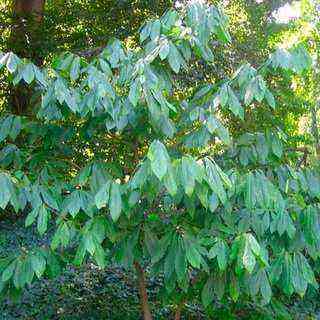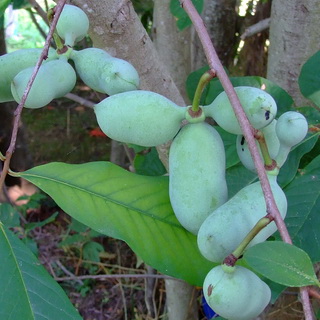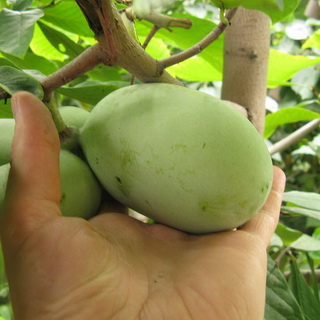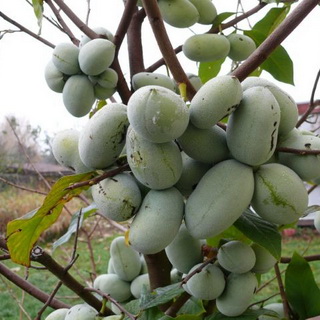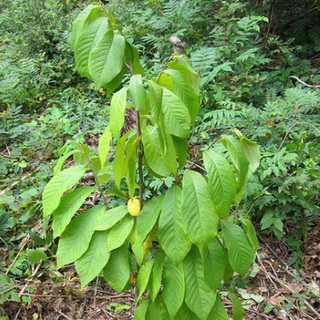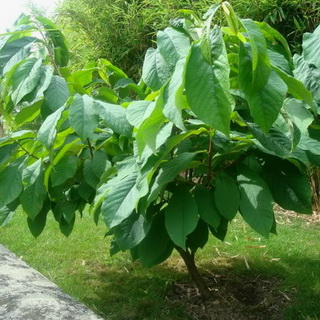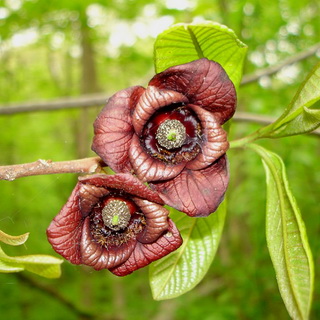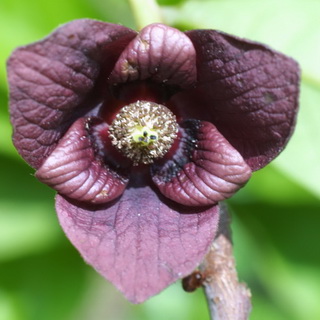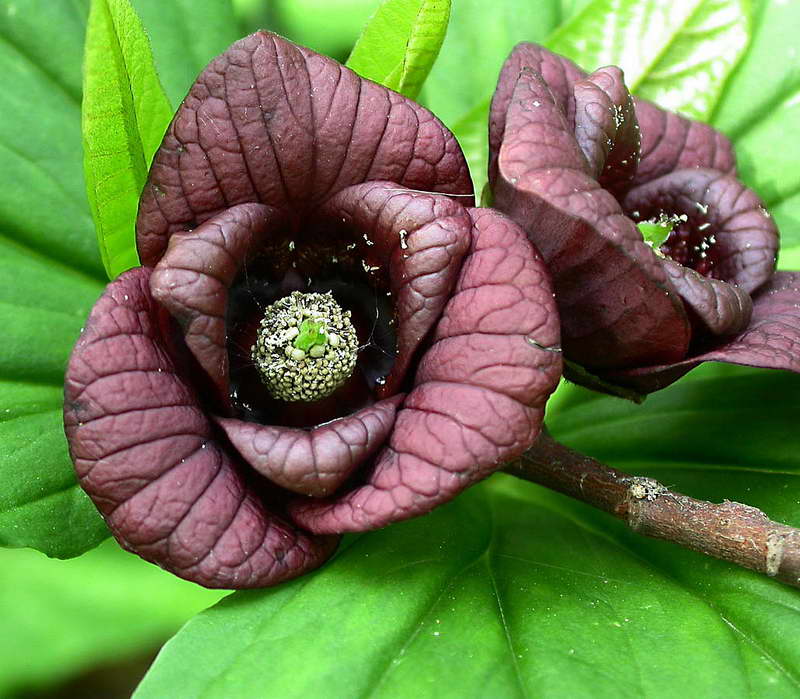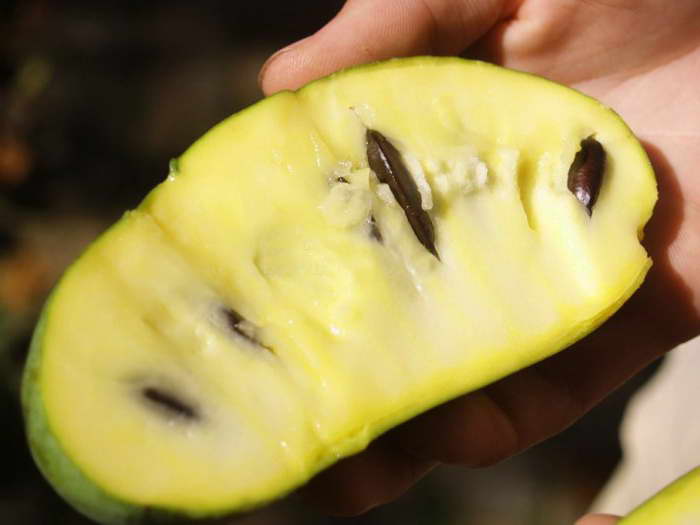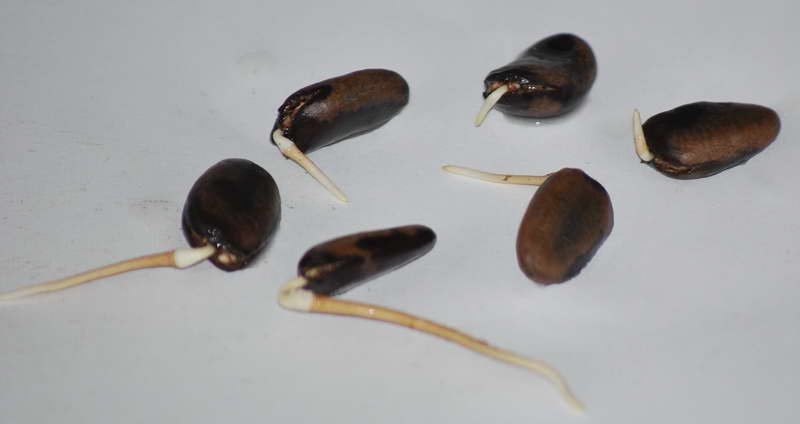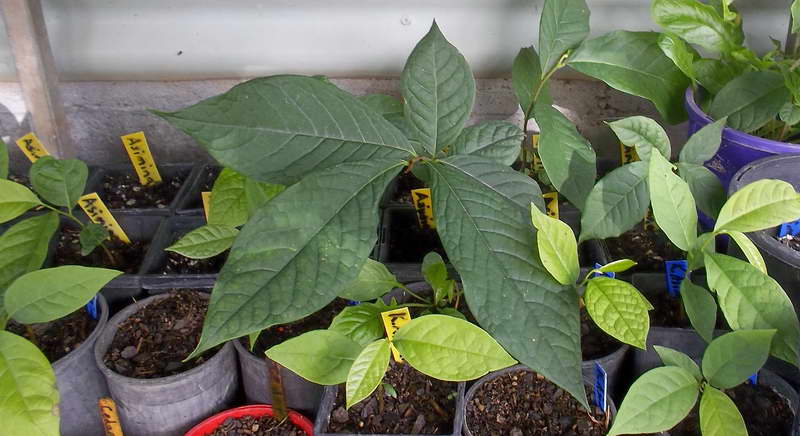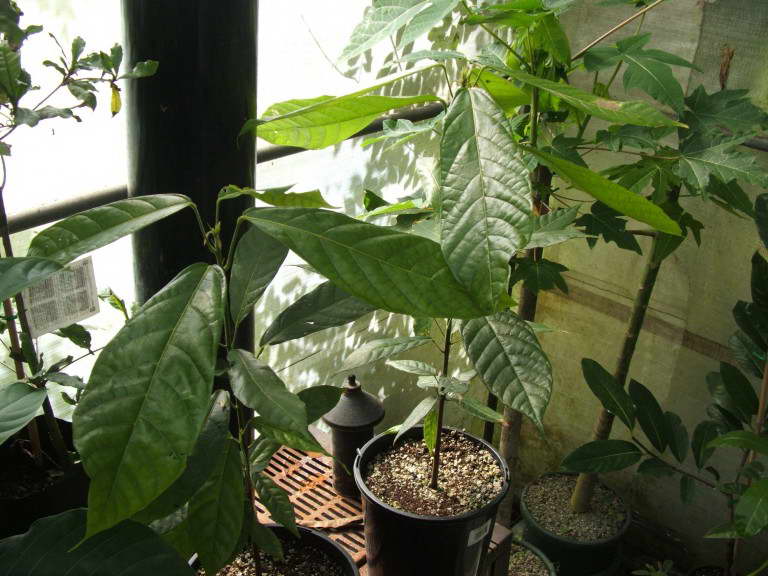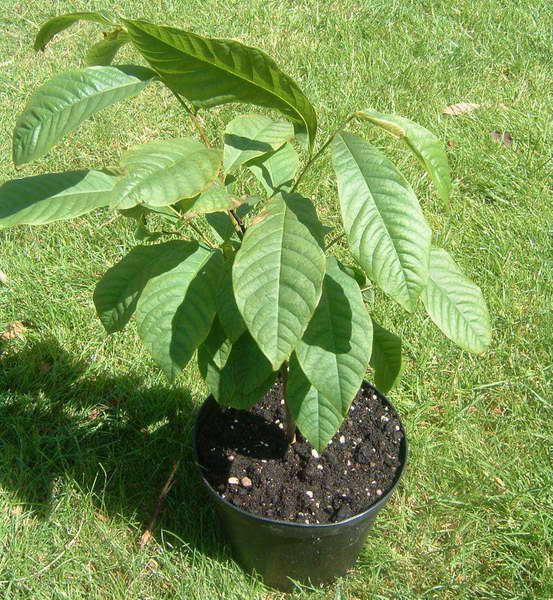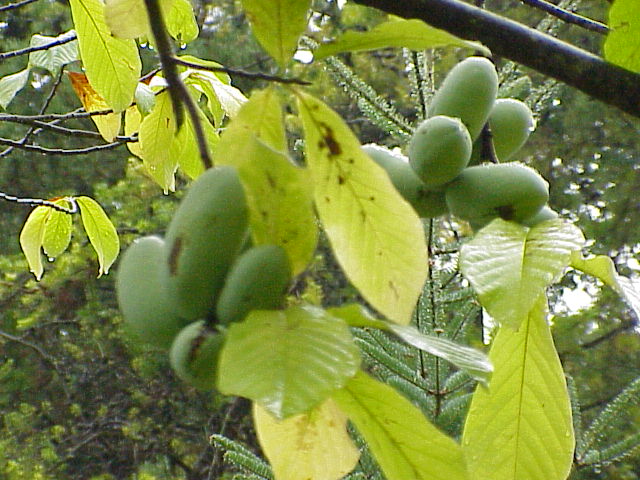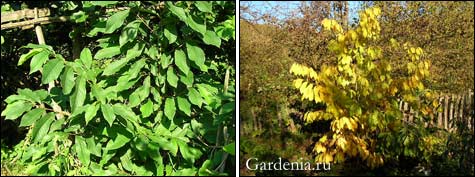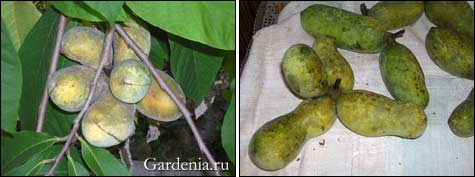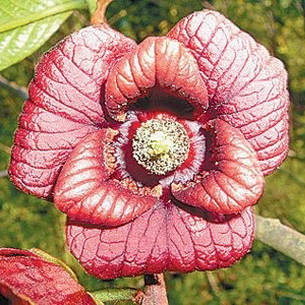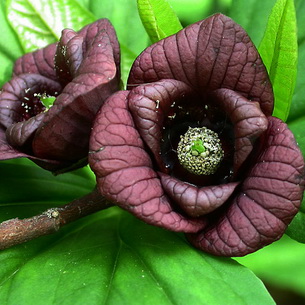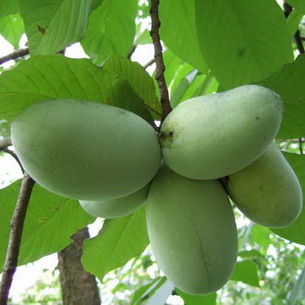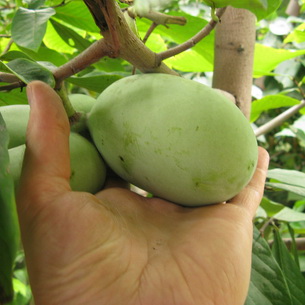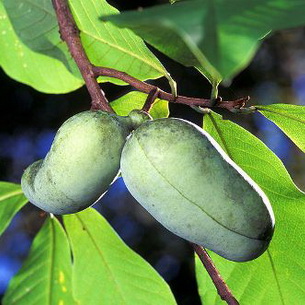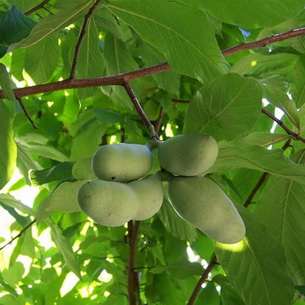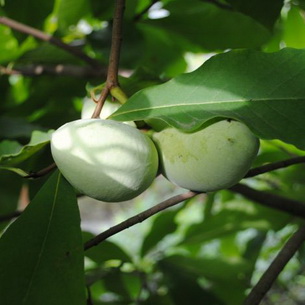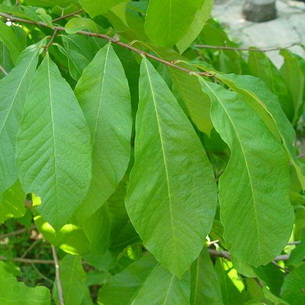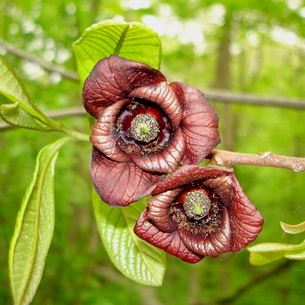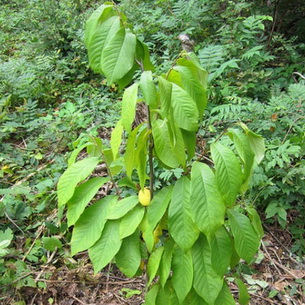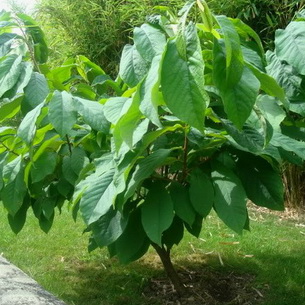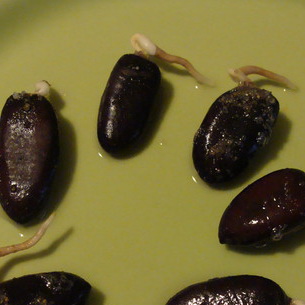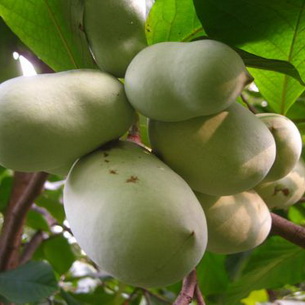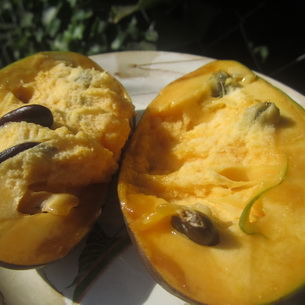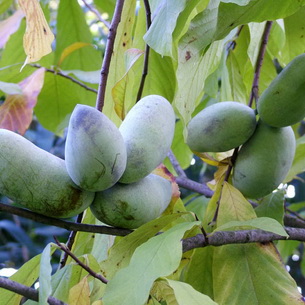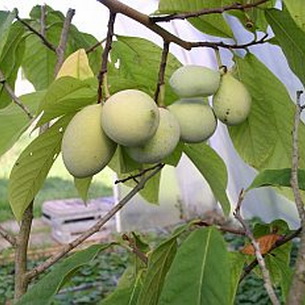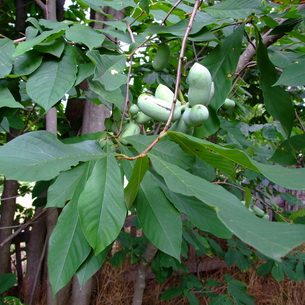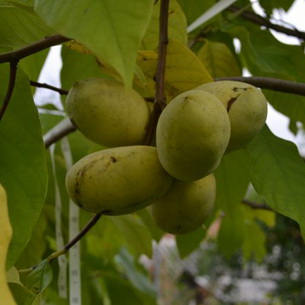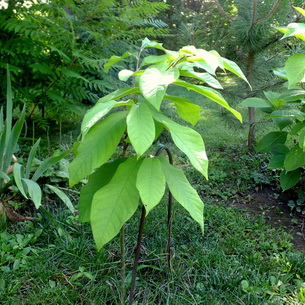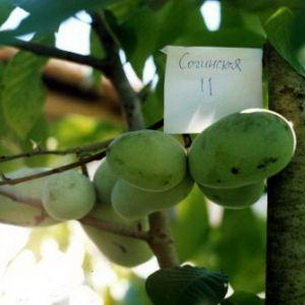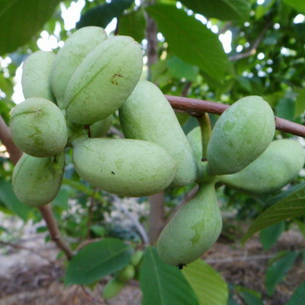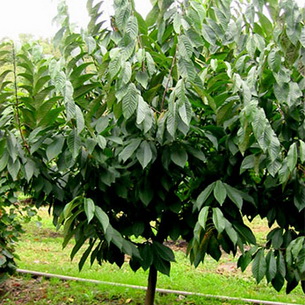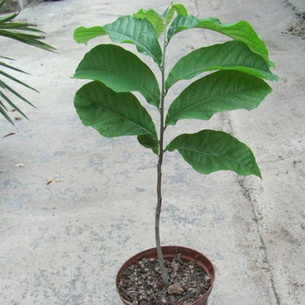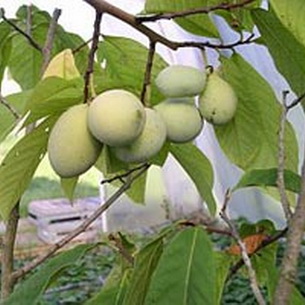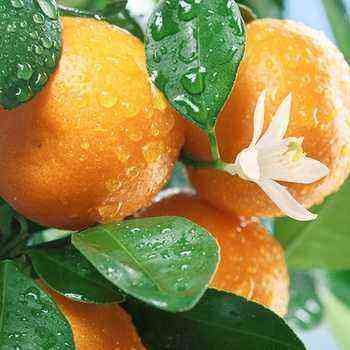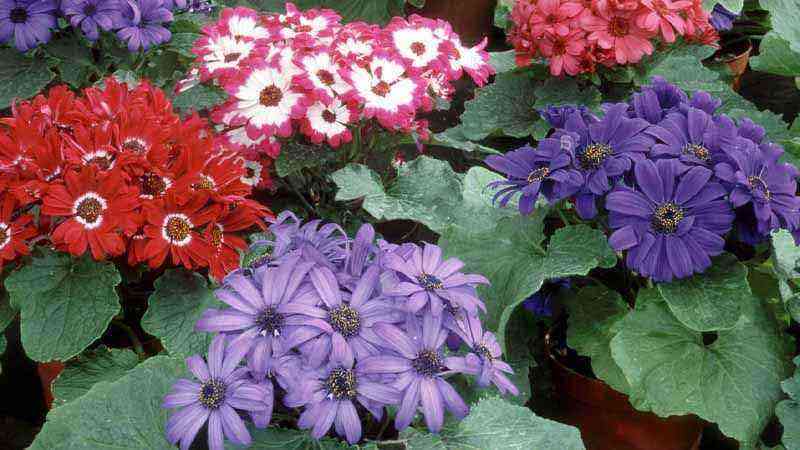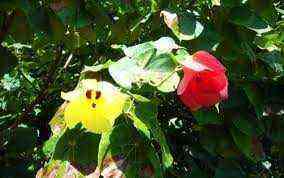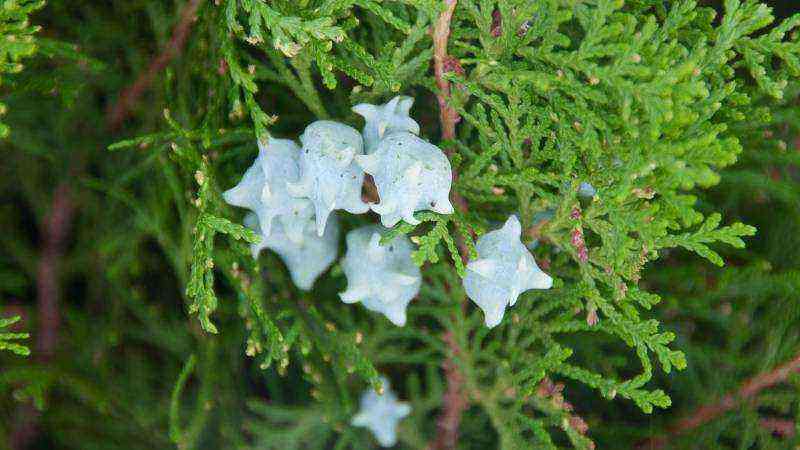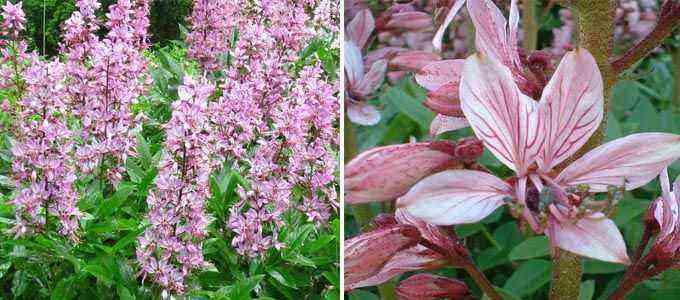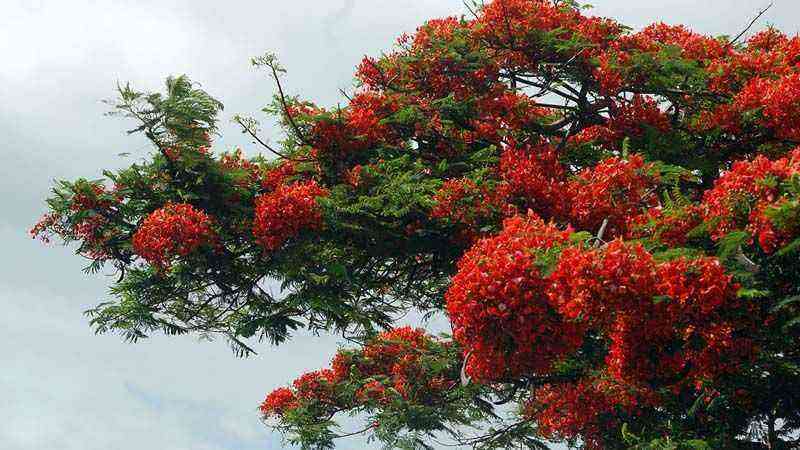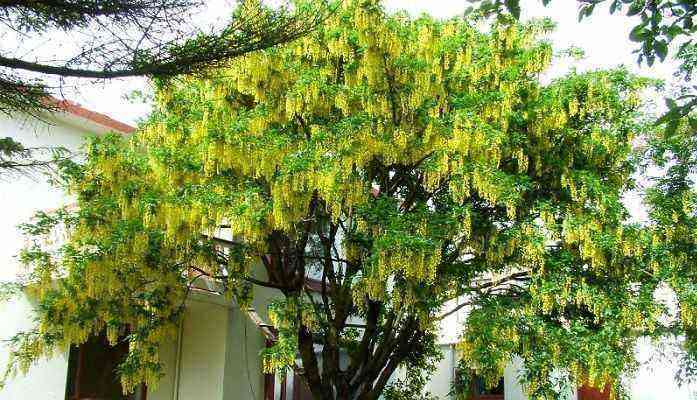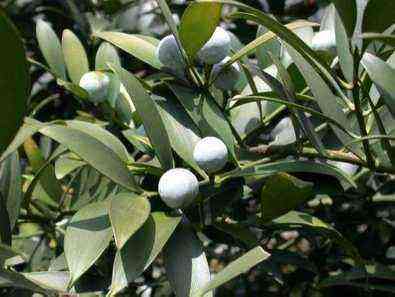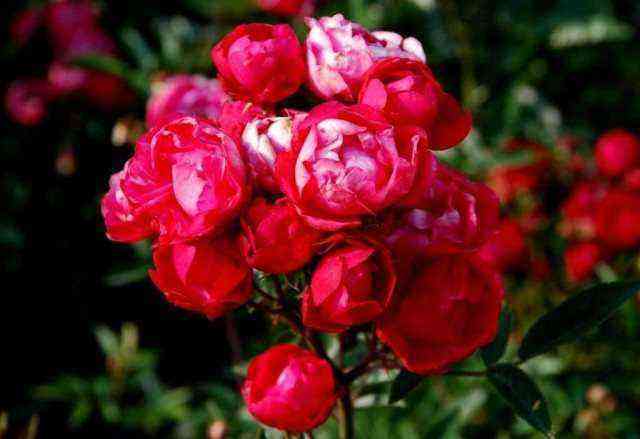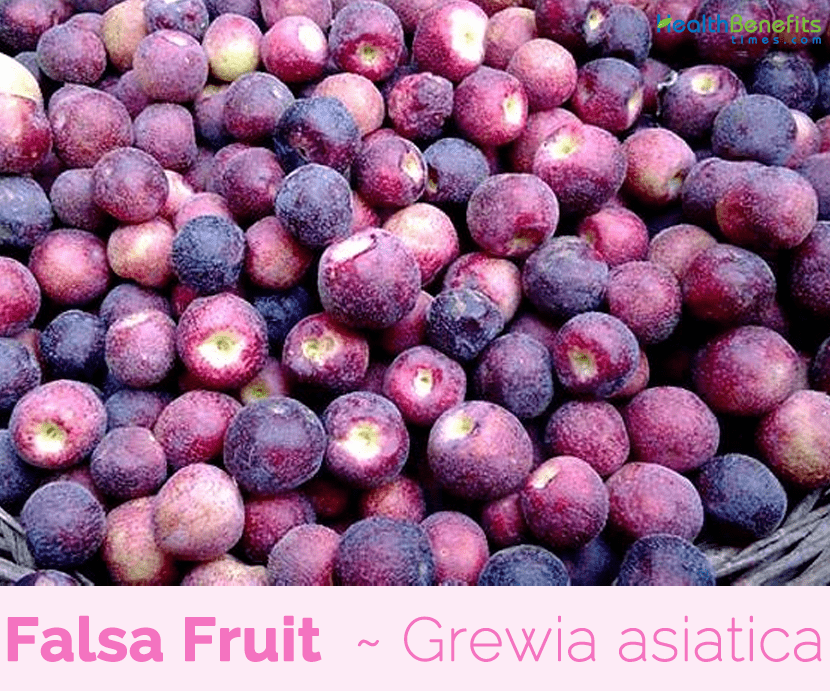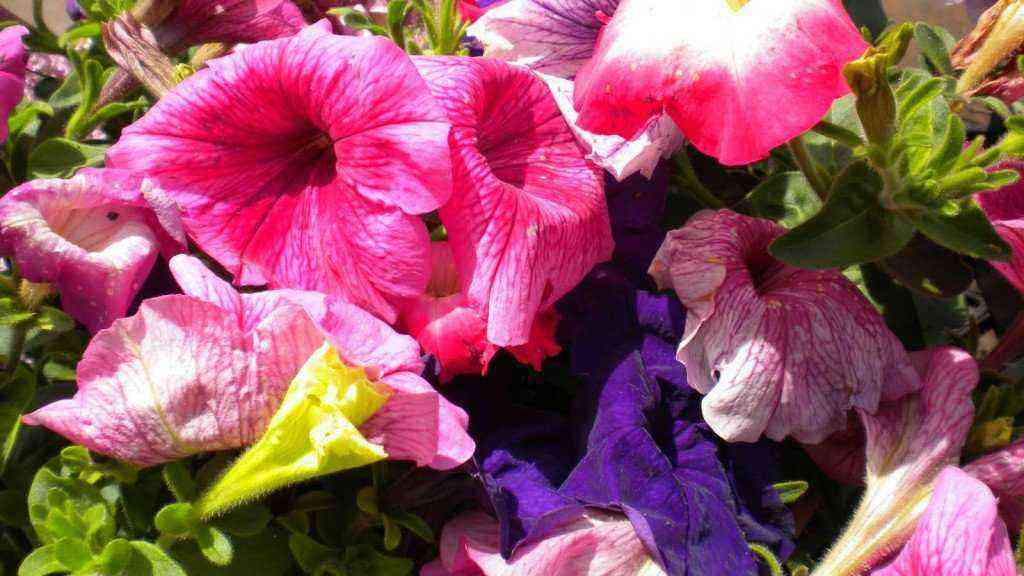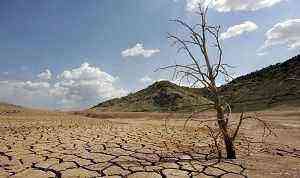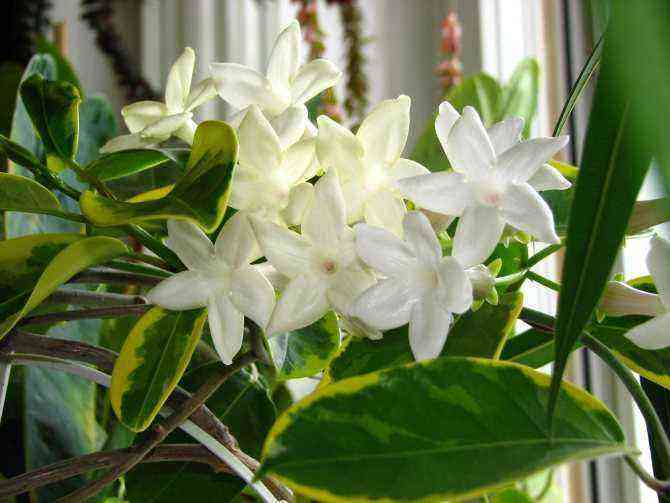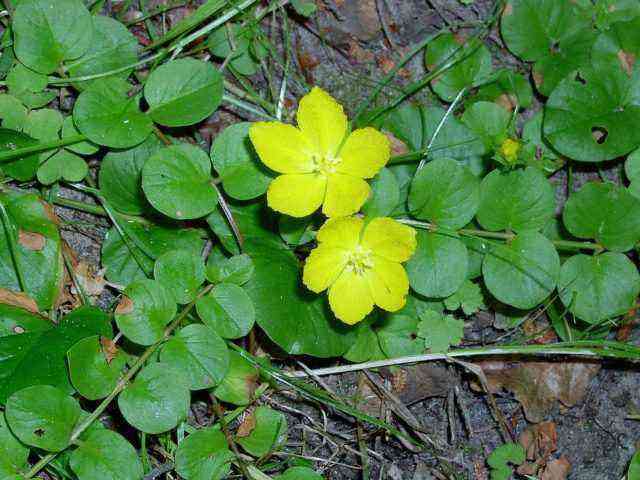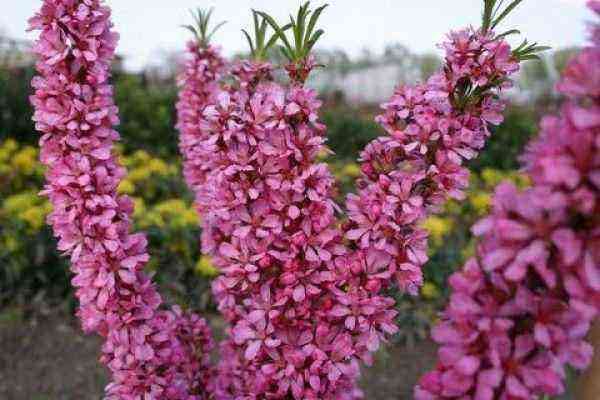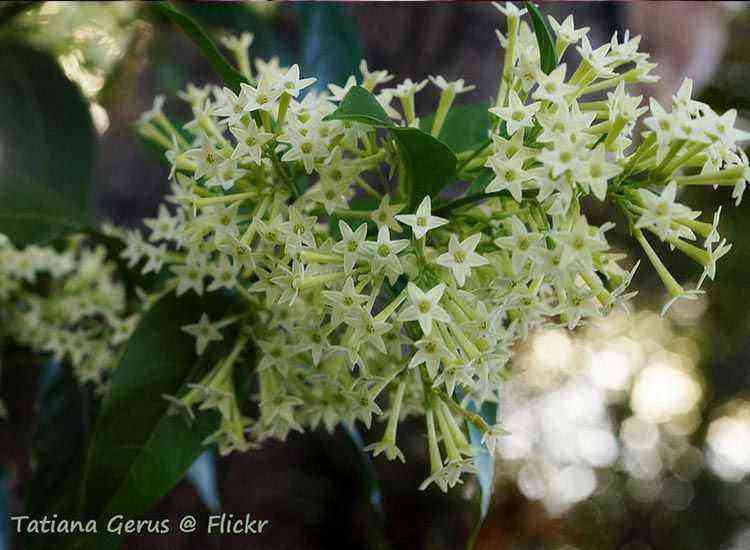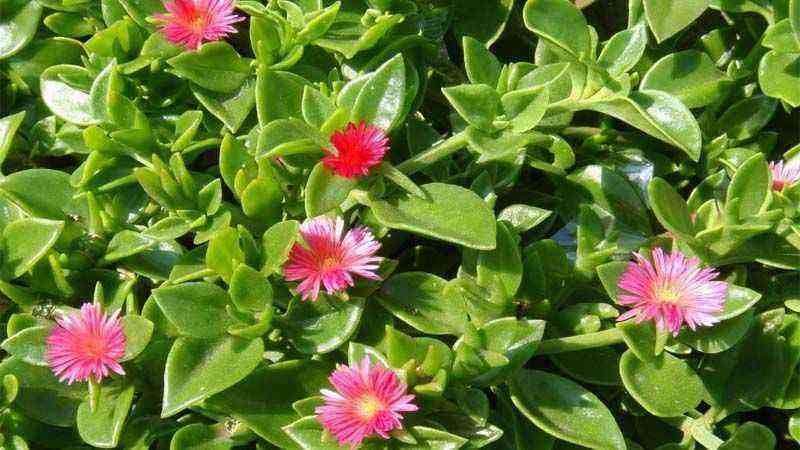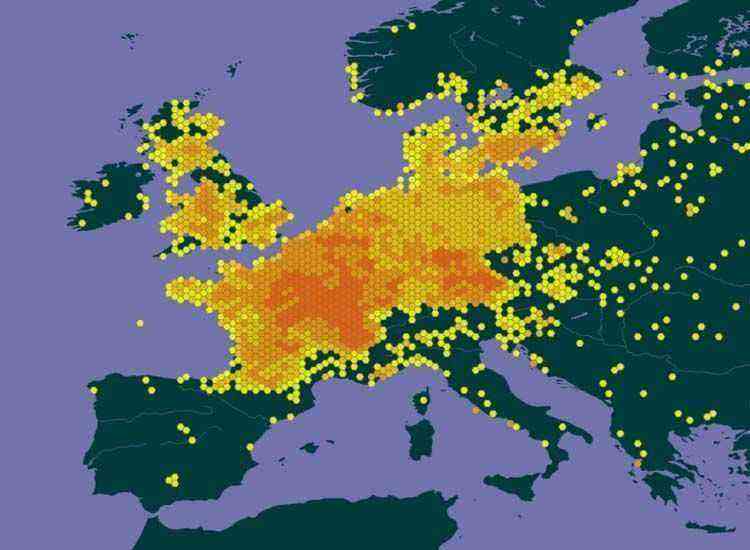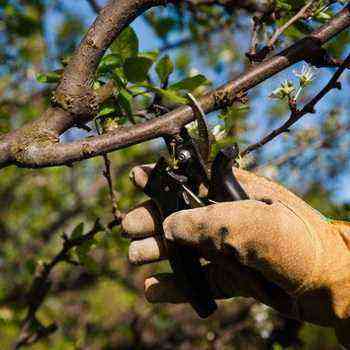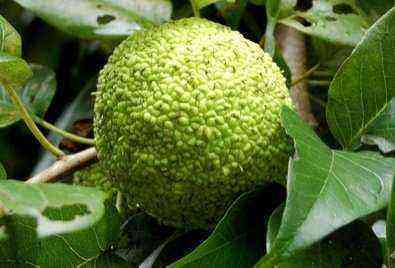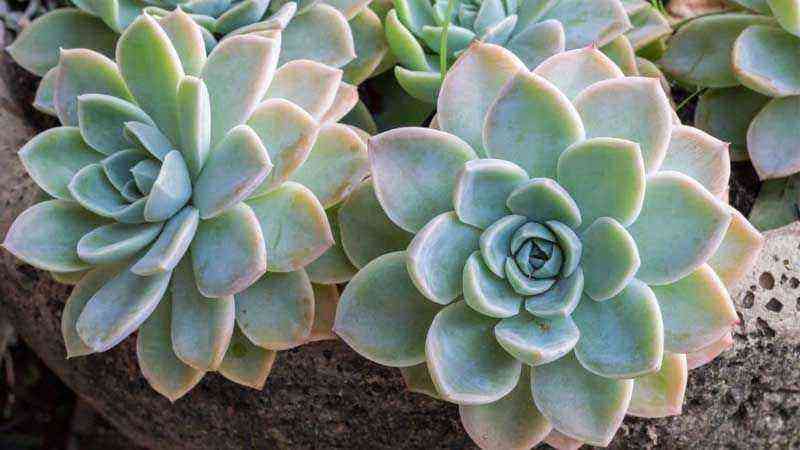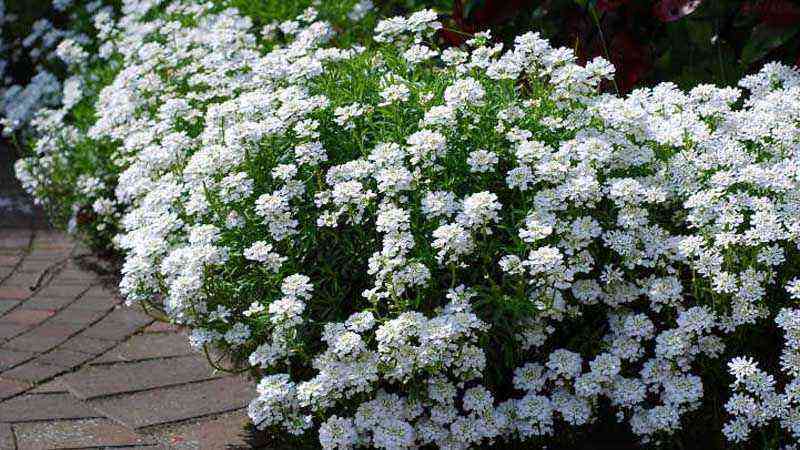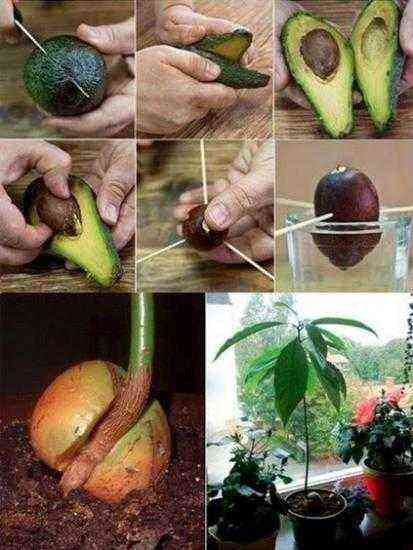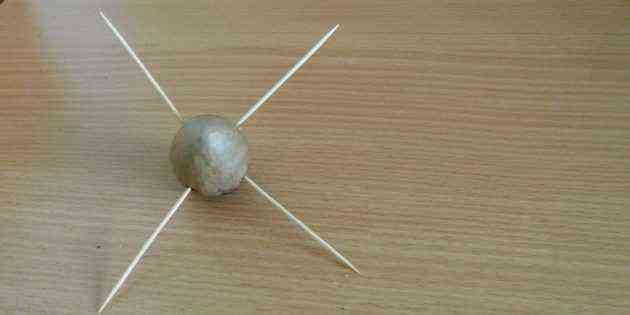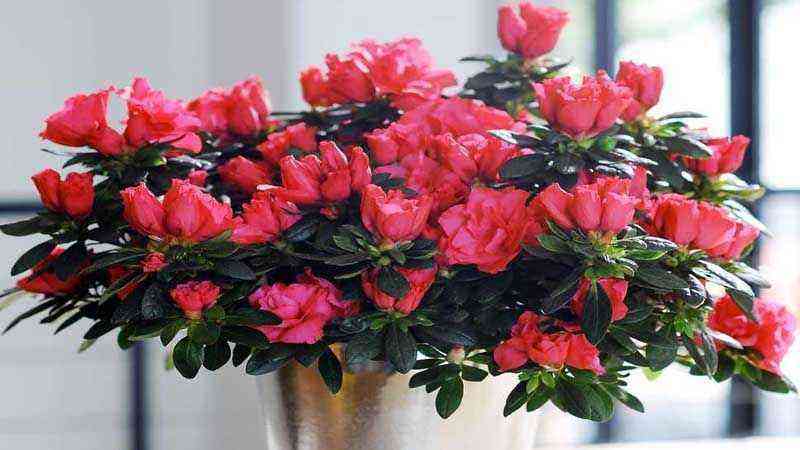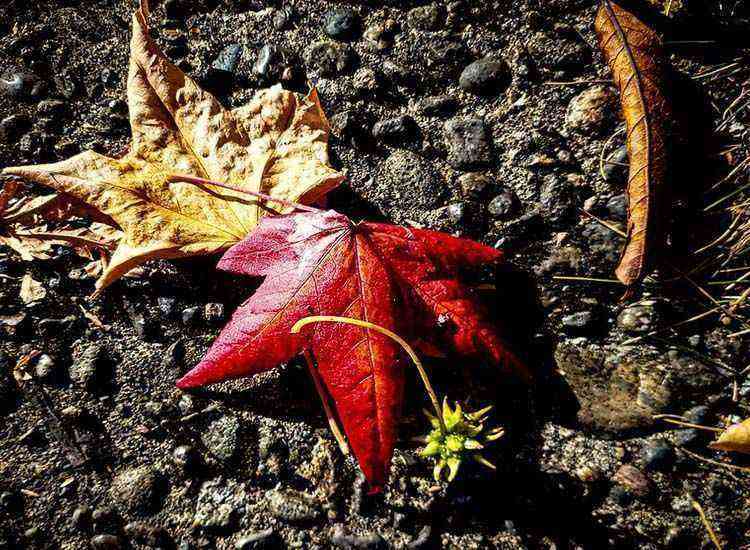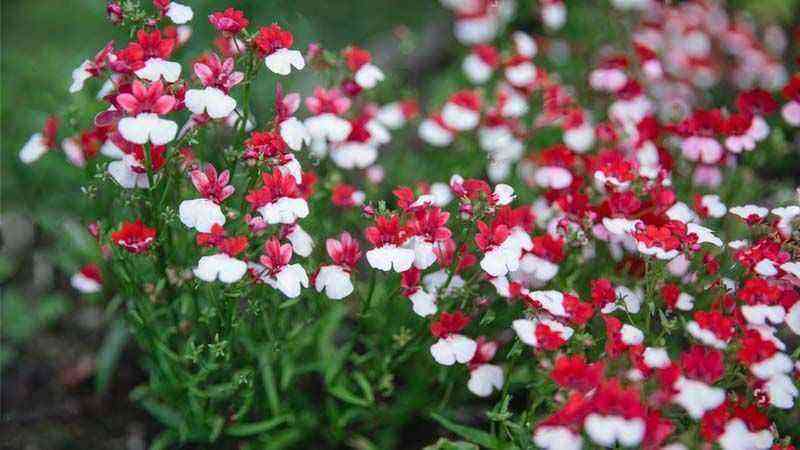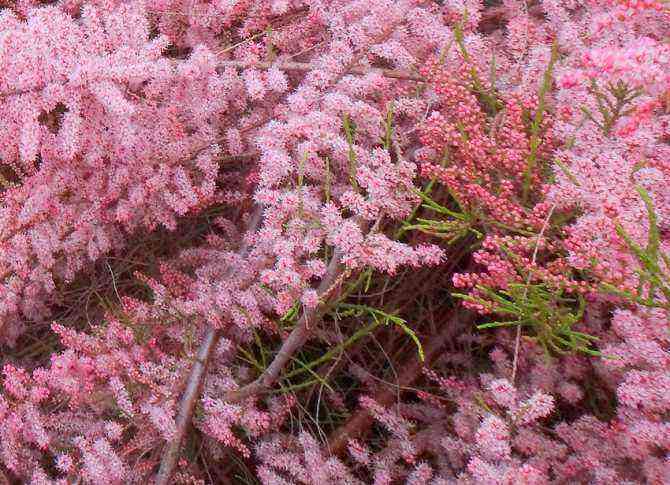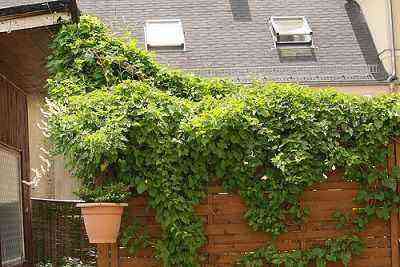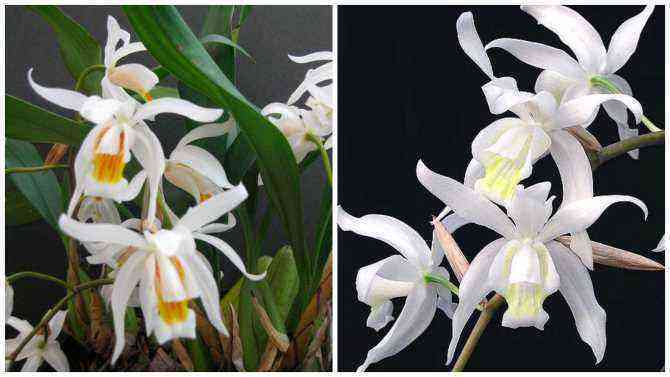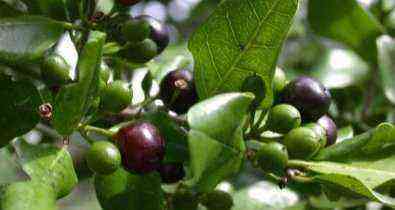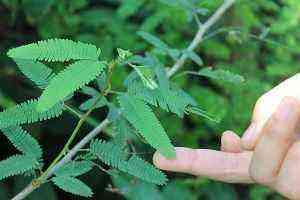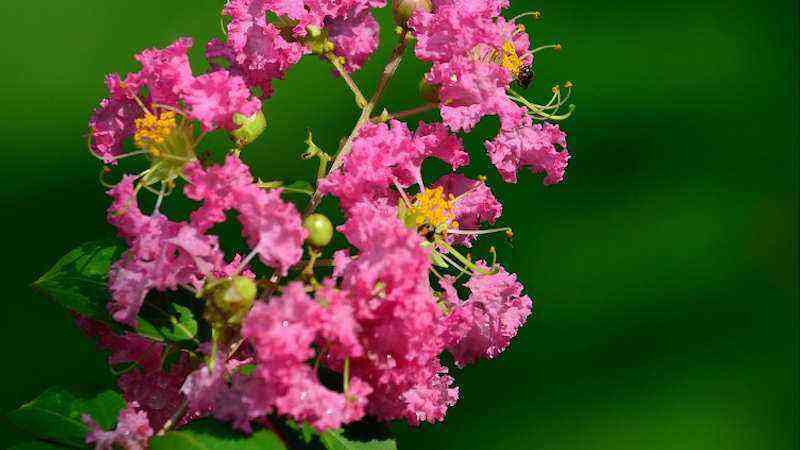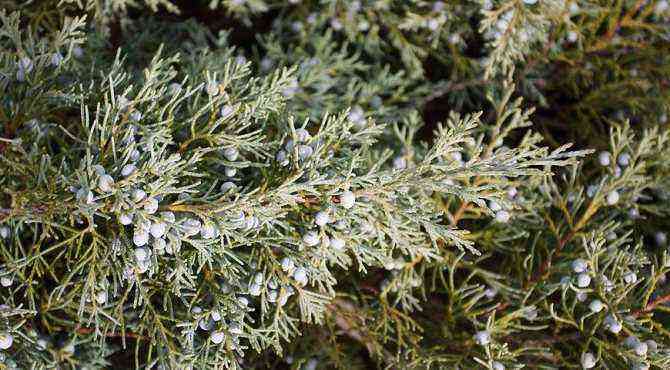Despite the fact that papaya is often called a banana tree, its fruits resemble bananas only in color, but in shape, they are very distant. They can be compared in size to papaya fruit, and to taste – to feijoa berries. It is impossible to grow this tree in the conditions of the Central Russian forest because of the plant’s increased thermophilicity, but you can try to propagate the culture at home.
Asimina, a banana tree (Asimina) belongs to the Annon family.
Homeland – subtropical North America.
Azimin, genus of deciduous and perennial plants of the Annon family. Shrubs, less often low trees with juicy edible fruits. There are 8 known species in North America.
A. trilobato ( A. triloba ) is cultivated in the Caucasus and Crimea as an ornamental plant.
Nowadays, papaya trees are also common in Spain, France and Italy; they were brought to Russia in the last century. The fact is that this plant is very resistant to frost and even tolerates severe winters with frosts (down to -29 ° C).
It is easy to dwarf an azimine plant, as it grows much shorter than its natural size in a container indoors.
Papaya is also called banana tree, Mexican banana, or Nebraska banana; She received these names for the oblong shape, like a banana, of the fruit. It is not just a fruit and ornamental plant; The seeds and leaves of papaya are used medicinally.
It is interesting that azimine is a representative of anonics little-known in our family, distributed almost exclusively in tropical countries. Some species of this family bear valuable and very tasty fruits. So, papaya is a “slightly tropical” plant. He reminds us that there are many incredible fruits in the world that we don’t even know about.
Banana tree description
It is a deciduous shrub, less often a low tree with edible juicy fruits. Begins to bear fruit in the 3-4th year of life. The fruit is light green, cylindrical; At the same time, there can be 3-5 fruits on the peduncle.
Look at the photo: the fruits of the clawed tree are 12 cm long and 5 cm in diameter:
Fruit weight 50-100 g. After ripening, the color of the fruit becomes lemon yellow. The skin of the fruit is very thin and tender, underneath it is sweet and juicy flesh with a pleasant aroma, reminiscent of a mixture of strawberries and pineapple. The pulp is rich in composition, contains valuable trace elements, fructose, sucrose. In terms of nutritional value, papaya fruit is compared to persimmon fruit. The flesh of the banana fruit has a whitish yellow hue and the consistency of butter. With proper care, the tree gives high yields (25 kg per tree or more).
When fully ripe, the fruit is very delicate and quickly deteriorates when squeezed and rubbed. When describing papaya, it is worth noting that its fruits are difficult to transport long distances or store for a long period of time. These fruits are for local use only.
It is a very ornamental plant with a wide pyramidal crown and beautiful smooth bark; leaves are quite large (up to 30 cm long and 10 cm wide). Large fallen leaves of the paw are damaged by strong winds, which should be taken into account when growing on a balcony or in a garden.
The flowers are beautiful, almost black, they appear on the plant even before the leaves. The flowers of the pawpaw are red-violet, monoecious, large (up to 4 cm in diameter); the cup consists of three leaves, a six-lobed corolla. Azimin blooms in spring, even before the leaves bloom; long flowering (about three weeks). It is a cross-pollinated plant; Under environmental conditions, artificial pollination with a soft brush or cotton wool is necessary.
Indoors, it blooms and bears fruit in the third or fourth year of life.
In October, the banana leaves turn yellow and fall off. Young leaves appear in May, after flowering. Flowers are solitary, formed in the axils of last year’s leaves. Formed in March – May. The flower consists of several pistils, so several fruits of each color (up to 9 pieces) can form.
Flowers are male and female, but the plant is not capable of self-pollination. For this reason, when growing Azimines, you will need cross-pollination, and this will require 2 trees.
Pollination should be done when the pollen turns brown and becomes loose. Also pay attention to the ends of the pistils – they should turn sticky and green.
The fruits of a banana tree ripen in a month. They contain up to 14 large black-brown seeds arranged in two rows.
And he is rarely affected by disease.
Types and varieties of papaya
Three-lobed azimine (A. triloba) is often cultivated under environmental conditions. Its flowers are artificially pollinated. A cross-pollinating plant, meaning two copies are required to create fruit.
Cultivation of azimine and seed reproduction.
When growing a banana tree, it should be borne in mind that it is photophilous, but young plants will need a light shade in the first 2 years of life. Adults prefer to be in direct sunlight. Azimine seedlings develop slowly, but with an increase in daylight hours (up to 16 hours), their growth rate increases: in three months, a young tree can grow up to 1,5 meters in height.
In summer you can take to the garden.
In winter, the azimine goes into deep rest. At this time, the plant is placed in a cool room, where it must live for at least 4 months. The optimum temperature in winter is 3-7 ° C.
Freely transfers dry air from rooms.
The substrate should be prepared from grassy-leafy soil, humus, peat and sand (2: 1: 1: 1: 0,5).
When caring for azimine, you need to regularly water the plant from spring to autumn, constantly keeping the soil moist; however, stagnant water should be avoided. In winter: very economical watering. The soil should not dry out.
During the growth period, 2 times a month, you need feeding with a full-fledged mineral fertilizer.
During active growth, azimine is fed every month with organic fertilizers (manure, pond silt), minerals (straw, ash or potatoes) and any complex fertilizers.
Papaya has fleshy and brittle roots, so it is not transplanted, but transplanted. Up to 2-3 years annually, then once every 4-5 years. Do this in the spring when the plant starts to grow. For good growth, a deep pot is needed, since the pawns have a developed root system.
Banana flowers and fruits are formed on last year’s shoots, so the plants must be cut to replace them. In addition, sanitary pruning of branches is necessary.
Use plant for warm and bright rooms, winter gardens.
Reproduction seeds and grafting with papaya seedlings (the latter method is very complicated).
When growing azmines from seeds, planting material for good germination must be stratified at a temperature of 0–4 ° C for 90–120 days. Seeds germinate after 7 weeks; When planted in late autumn in the ground, seedlings can be expected in July next year. Young pawpaw spawns have a sensitive root system, so it is not recommended to replant them.
Plants grown from seeds usually begin to flower and bear fruit after 4–8 years, depending on seed quality, variety and conditions. A grafted tree can bloom in 2-3 years, but it is very difficult to plant azimine.
The video “Growing Azimin” shows how to care for this plant:
Asimina is the only genus of deciduous shrubs and trees in the Annon family that can withstand extratropical conditions. Six out of ten species are common in the southern United States (Texas, Nebraska, Ohio, Georgia, Florida, Virginia), another one; in the east, some of them are located in Spain, Italy, France, Japan.
The three-bladed azimine (Asimina triloba) from Canada (Ontario) has the best winter hardiness. The plant can withstand frosts down to -30 ° С, it is successfully grown in temperate climatic conditions bordering on subtropical ones. On the territory of central Russia it also took root well.
Under natural conditions, papaya bushes grow up to 4-5 m in height, and trees can reach fifteen meters in height. On the site, growth is limited to 2-3 meters. The plant loves to settle along the banks of rivers, provided that the soil is loose and moderately moist, it forms practically impenetrable thickets in nature. The trunk and shoots are covered with a soft gray bark, young branches have a slight pubescence.
The spreading crown has a pyramidal shape. Elliptical leaves are narrow from the base, reaching 7 cm at the widest part, again tapering towards the top, leaf length 20 cm. They are strong and firm to the touch, because of the shiny surface they seem artificial, thin lateral branches emerge from the central vein. The young leaf has a bright green hue on the front, and as it darkens to a grayish hue, the back has a dull brick hue.
Winter hardy papaya
Azimina is unpretentious in care and is resistant to cold (the tree can withstand temperatures down to -30 ° C), but for fruiting it can only be grown in regions with a temperate climate (Black Sea, Crimea, Krasnodar Territory, Caucasus.). The growing season, together with fruiting, lasts 160 days, therefore, in the Moscow region, the Volga region, Belarus, the non-European part of Russia, azimine is grown as an ornamental deciduous plant.
In central Russia, winter is both hot and abnormally cold. It is advisable to completely cover young plants with a cardboard box, covering the trunk circle with straw, shavings and pieces of paper. It is advisable to wrap the base of the stem with breathable material: spunbond, agril, burlap or a piece of nylon stockings.
For an adult tree, clear the circle of the tree trunk from debris, pour a mound of soil around the trunk with a height of 25-30 cm, cover the circle of the tree trunk with a layer of peat or humus 10 cm thick. on the surface of the infusion.
Flowering and fruits of the azimine.
Leaves bloom only in late spring, preceded by flowers that bloom in mid-April. To prevent the corollas from suffering from spring return frosts, nature protected them with a dense shell cover. The flower is exotic and very decorative: a dense rounded core of a milky shade is framed by three inner and three outer petals. Their surface is speckled with veins, the color of the petal is dark scarlet, lilac-violet, which makes them look like a tongue. The corolla does not exceed 6 cm in diameter. The flowering period lasts about 20 days, a separate corolla lives for 7 days.
Each flower has several pistils, so from 3 to 9 fruits can be tied on it. If the purpose of growing is fruiting, at least two plants should be planted in this area for the pollination process. The flowers exude a light smell reminiscent of rotten meat.
If the inflorescences fall off in early summer, then they are not pollinated and do not bear fruit. In the middle of summer, there is a risk of losing part of the existing ovary if it is hot and dry. It takes 160 days to reach removable ripeness at an ideal temperature of 18 ° C, they heat up faster in hot weather. Fruiting of the banana tree occurs in September and early October.
Papaya fruits are similar in shape to papaya: oblong, angular, 5-15 cm long and 2-8 cm wide, weight ranges from 50-350 g. Heat and drought adversely affect size and weight. The skin is pale green or yellowish, very thin and easy to remove, but very afraid of mechanical damage. The fruit is edible and has a flavor reminiscent of a mixture of banana, mango, feijoa and pineapple. The texture of the pulp is pasty, a shade of butter, exudes a strawberry aroma with cream, Americans compare it to custard. It contains neatly oblong bones of a black-brown shade with a shiny surface, from 8 to 14 in total.
Thanks to the fruit, papaya has many other names: paw paw (similar to papaya fruit), Nebraska banana, norteno, canino, Mexican banana, poor man’s banana.
Useful properties and productivity of papaya
Mineral and vitamin composition
The fruits not only have an unusual taste, but are also very useful. Nutrition is about 360 μCl per 100 g of weight, the same weight contains 50-60 mg of vitamin C, potassium, magnesium, calcium, carotene, phosphorus, copper, essential amino acids (tryptophan, arginine, lysine).
Fruits do not cause allergic reactions, but the high concentration of fructose and sucrose prevents diabetics from eating them. Berries can be stored fresh for no more than 2-3 days, in the refrigerator – 5-6. Delicate delicious gruel is put into cooking, added to creams, prepared with jam, ice cream, jam, jam, you can make compote, but the shelf life does not exceed a month.
The healing properties of papaya
The medicinal properties of the plant were already known to the ancient Indians. A decoction of azimine leaves was taken as a diuretic and anthelmintic; an emetic was prepared from the seeds. The anti-inflammatory, antioxidant and antiseptic properties of the northern banana have been scientifically proven. Taking medications prevents the development of tumors, including cancer, and, if present, inhibits their growth, slows down the aging process, and helps remove toxins and toxins from the body.
Productivity of one tree
From one tree per harvest from 25 to 40 kg of harvest. Fruits must be removed on time, avoiding falling, because after damage they are not light, spoiled fruits acquire the taste of burnt coffee beans. The fragility of the fruit makes transportation impossible. Azimin is definitely not suitable for industrial cultivation. Of interest is only the cultivation of a few trees on a private garden plot.
Growing azimine in the open field
You can count on the fingers of the exotic fruit-bearing plants that can be grown in the unstable climate of central Russia and Ukraine, Belarus. Growing papaya is difficult, but the unique taste of the fruit and the beauty of the exotic flower are worth it.
Firstly, the trunk and branches of papaya are fragile, they can break under the weight of snow, from strong gusts of wind, and even a modest harvest can become a heavy burden on the tree. Be sure to install a trunk support, harvest fruits in time, remove the snow layer in winter.
Secondly, it is not easy. Seeds germinate with difficulty, some seedlings die, after transplantation into open ground, the survival rate is long. Fruiting begins between 5 and 6 years of age, but until now papaya will serve as a decorative decoration for the foliage of the site. It is good that the Nebraska banana has lived for about half a century, you will definitely like its fruits. Due to the structural features of the root system, azimine shoots are extremely rare. It must be adapted to reproduce by vaccination.
How to grow azimine from seeds
Note: when varietal traits are not inherited, if the mother plant is a hybrid. Choose azimine seeds from the largest and most likely healthy fruits (no damage, mold, or signs of rot). Be sure to stratify the seeds or they won’t germinate at all. After removing the fruit, they quickly lose moisture and stratify immediately after collection.
- In a small container filled with a mixture of sand and peat in a 1 to 1 ratio, sow a few seeds, deepening them 3-4 cm.
- Cover with a clear bag and place in a cool, damp place between 0 ° C and + 4 ° C (the vegetable compartment of the refrigerator is ideal).
- After 3-4 months, we take the container out of the refrigerator, remove the seeds from the substrate, soak it in a growth stimulant solution and plant it in separate pots with a mixture of sand and peat, embedded to a depth of 3 cm.
- If the seeds have already begun to hatch, then you do not need to go deeper: carefully place them on the substrate and lightly sprinkle them with earth on top so as not to damage the roots.
In both cases, spray the soil with a fine sprayer, cover the container tightly with glass or a transparent bag and place on a shiny windowsill, the air temperature should be at least 25 ° C.
Hostile people appear at 6-8 weeks. During this time, lift the cup / bag for ventilation daily and spray a fine spray as needed.
Grow seedlings without shelter, moderate watering, 12-15 cm high, plant in separate pots. Only open annual seedlings outdoors.
Vegetative propagation of azimine
The banana tree sometimes produces root shoots. Experienced gardeners recommend digging up, and cutting the root connecting the shoot with the mother plant by 1/3, it will be necessary to cover it with soil. This is done so that the root system of the shoot develops more actively. If such manipulation is not carried out, be sure to create a greenhouse environment for the planted sprout, covering it with a bundle. The key to survival is regular watering, but not too abundant, from time to time the greenhouse is ventilated.
Reproduction by part of the rhizome is allowed. Cut to a length of 8-10 cm and plant in a mixture of sand and peat. We place it horizontally, deepening 5 cm into the ground. Until next spring, we grow azimine seedlings at home: diffused lighting, moderate watering, we keep the air temperature within 22-25 ° C.
Papaya requires certain skills, and such plants will bloom in 2-3 years. The graft is an absolutely healthy shoot tip 12-15 cm long, taken from a five-year tree. The tip is cut in a wedge shape directly into the stock.
We graft into the slot: on the diameter of the stock we make an incision 1,5 cm deep, insert the scion there, the connection should be tight. We wrap it with several layers of polyethylene and fix it on top with electrical tape, remove all the lower side branches of the stock. Due to the high tannin content, areas in the air rust quickly, so we act quickly. Root engraftment is 1,5-2 weeks. This is evidenced by the formation of new leaves, callus appears at the attachment site (a kind of inflow of connective tissue).
Open azimine in an open field
When to plant
The transplant process is a great stress for the azimine, he is “sick” and in this state will not survive the coming winter in 1-2 months. Even in the southern regions, it is recommended to plant only in spring, after the threat of return frosts has passed.
Where to put the papaya
A place for growing papaya, as for any tree, should, in principle, be chosen once and for all. Azimina loves light and warmth, so plant in areas heated by the sun without drafts and strong gusts of wind (remember the fragility of the crown).
Ideal if there is a fence or wall on the north side in the distance. The root system does not tolerate moisture and waterlogging of the soil poorly. Lowlands, flooded areas and places where groundwater passes to a depth of less than 2 m are categorically not suitable. The first two years after planting, trees may suffer from the rays of the scorching sun. It is recommended to cover them with a canopy of a couple of layers of gauze or other covering material in white.
Landing characteristics
There are no special requirements for the quality of the soil: it must be light, loose and slightly acidic (pH 5,0–7,0). On heavy clay soils, azimine can also grow, but the rate of development is slow and abundant fruiting should not be expected. We prepare the landing pit in advance, about 3-3,5 weeks before the transplant.
We dug it 50 by 50 cm in size. Mix the most fertile upper part of the excavated soil with compost or humus (pour 1 bucket of 10 liters each), add wood ash (1 liter can), which can be replaced with 40-50 g of superphosphate and 20-30 g of potassium sulfate
If the soil is clayey, heavy, add 2 buckets of coarse river sand; a layer of expanded clay or pebbles can be placed on the bottom of the planting pit. We put the prepared soil mixture into the well and wait for the soil to settle, settle.
1 hour before planting, the seedling in a container is watered abundantly to facilitate the removal of a lump of soil (if the pot is cloudy, you can plant it). Cross with maximum preservation of the earthy coma. To stimulate the appearance of basal processes, seedlings can be placed at an angle of 40-45 ° C.
When deepening loose soil, the root collar is deepened by 10-12 cm, in clayey – by 5-8 cm. Do not pierce the ground close to the surface, just gently press it with your palms around the trunk. Pour 2-3 ten-liter buckets of water abundantly. After absorbing the liquid, cover the log circle with humus or peat chips.
Azimin is a non-self-pollinating plant, so it is advisable to plant at least two trees on the site. Therefore, keep the distance between them 3 meters, between the rows – 4-4,5 m. You can manually pollinate by transferring pollen from one flower to another with a brush. The flowers give off a smell similar to rotten meat, so they can attract flies to help pollinate.
Outdoor Azimine Treatment
How to water
Although in its natural environment, azimine prefers to grow along the banks of water bodies, stagnant moisture in the area adversely affects the root system. In the garden, it is watered only in extreme heat. Every 10-12 days, under each tree, depending on age, add 4-7 ten-liter buckets of water. From the end of August we gradually reduce watering, in the middle of October we completely exclude it.
Top dressing and mulching
Never dig the soil in a circle close to the pawpaw’s stalk, it can be loosened at most on the surface, going deeper by 2-3 cm. Mulch will help keep the soil moist and save time because the gardener does not have to loosen the soil surface after each watering. In the spring, gently loosen the soil and pour a layer of compost or humus into the circle of the trunk (under an adult tree, you will need 2-3 buckets of 10 liters each). Add any mineral nitrogen fertilizers (ammonium sulfate, urea) to the mixture every 2-3 years.
The tree reacts positively to fertilizers, it is allowed to use organic matter and mineral fertilizers, alternating them. If you replenish the pit during landing, the power will be enough for the first few years. Then every spring (around mid-April) feed with nitrogen-containing fertilizers. An infusion of chicken dung, mullein, dandelion leaves or nettle leaves is very suitable for this. Throughout the season, feed fruit trees with organic or complex mineral fertilizers (Master, Kemira Lux, Agros, Zdraven, Dobrota Sila, etc.). In the frequency and proportions, follow the manufacturer’s recommendations.
Poda
Trim your pruning back in the spring. The plant bears fruit mainly on last year’s shoots, so pruning is necessary for replacement: half of the shoots with flower buds are cut off by or 1/3 (for fruiting), the rest – on the named growth, shortened to 2-3 shoot. For sanitary purposes, we cut off dry, frozen and damaged branches. No pruning is necessary.
Papaya at home
Azimin can grow and bear fruit indoors. Even special dwarf varieties up to half a meter in height have been bred, of course, their fruits are small (about 4 cm long), but no less tasty. The growth of other varieties is regulated by pinching the top, achieving a tree height within 1,5-2 m. If the dimensions of the room allow, then there is no need to delay growth.
Ease
Photophilous papaya needs bright lighting throughout the year. Plants up to three years of age are exposed to direct sunlight, so place the pot on the southeast or southwest window sill, it is advisable to move it to the south for the winter. By the way, to accelerate the growth rate, you can use additional lighting with phytolamps or fluorescent lamps, increasing the daylight hours to 16 hours. In about 3 months, the tree will grow half a meter.
Transmission
Fresh air will not hurt. For the summer season, “transfer” the azimine to an open balcony, veranda or terrace, protecting it from strong gusts of wind and rain. If you leave it indoors, keep the temperature between 22-25 ° C and ventilate regularly.
Irrigation and moisture.
The plant prefers rare, but rather abundant watering; between procedures, the soil surface should dry out. In the heat, water almost every 2 days, the rest of the time – once a week.
Indoor humidity levels are not critical for papaya. However, spray the tree from time to time with a fine spray until the ovaries and fruits are gone. Wipe the leaves with a damp sponge.
For spraying and watering it is necessary to use softened water (rain, thawed, filtered or let stand for at least 48 hours of tap water).
Dressing
From April to late September, papaya is fed every 10-12 days. Due to the smell, organic matter in the room is rarely used, it is more convenient to use complex mineral fertilizers for fruit crops. When the pot is on the street, you can connect organic products, literally 1 hour before application, water the tree so as not to burn the roots.
Transfer
Azimine transplant is perceived painfully, it is good that it can be planted in a pot “for growth.” Take care of the presence of drainage pits, put a layer of pebbles, expanded clay, fragments of clay or small pebbles on the bottom. Emergency transplant, cultivation of a piece of land. Pour immediately with warm water, after which do not moisten the soil for 5-7 days. As a substrate, we prepare a mixture of humus of soil, leaves and grass in a ratio of 2: 1: 1. For each liter of the mixture, add a handful of river sand and 1 tablespoon. Ash tablespoon.
Rest period
In winter, the tree should be kept at a temperature of 3-8 ° C, but the lighting requirements remain the same. You do not need to feed, moisten the soil every 3-4 weeks.
Diseases and pests of papaya
Azimin does not suffer from pests and diseases, and the gardener is able to harm himself by frequent and / or abundant watering. The danger is root rot. Signs of damage: dark dark leaves, dark spots on the fruits, the base of the trunk turns black and “cries”, the surface of the soil is covered with mold, and a rotten smell emanates from it. Irrigation must be completely stopped. Two or three times with an interval of 4-7 days should be treated with a solution of a fungicidal preparation such as Skor, Topaz, Kuprozan, Abiga-Peak. The plant can only be saved in the early stages. If the defeat is severe, the tree will have to be dug up and burned. The area in the garden must be treated with a solution of copper sulfate with a concentration of 2%.
The high immunity of the plant is due to the high content of tannins. To avoid possible problems, avoid the accumulation of water in the soil, and in order to avoid root rot, water the azimine with a solution of potassium permanganate of a slightly pinkish shade every month.
Types and varieties of papaya
At home, Nebraska’s bananas are well known and loved. Recently, it became known about the decoration of the tree and the original taste of the fruit for the gardeners of Asia and Europe in Russia. Even a little cultivation experience made it possible to reveal the nuances of cultivation, care, reproduction and harvesting.
Of the dozens of representatives of the genus in the conditions of central Russia, only the three-bladed azimine will take root. The best varieties bred by American breeders are Davis, Rebecca Gold, Pennsylvania Gold, PA, Sunflower. Domestic breeders gave us Michurinka and Sochinskaya varieties.
The banana tree looks decorative and gives us very tasty and sweet fruits, which many compare in shape to shortened bananas, and in taste to some tropical fruits such as pineapple, banana, mango, papaya.
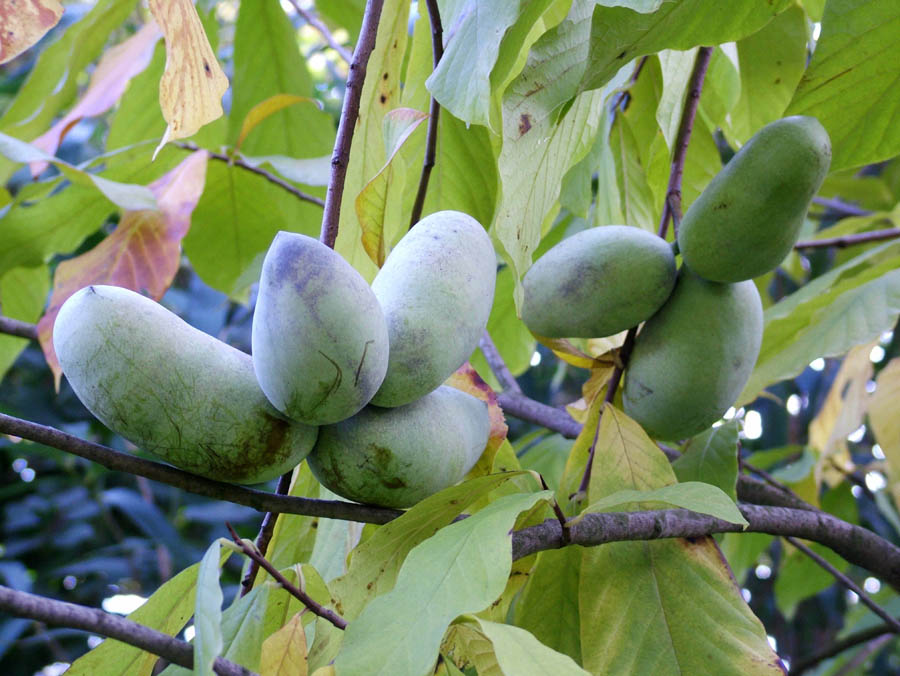
Three-lobed azimine (Asimina triloba), despite its exotic appearance, is not a tropical plant. This is a low deciduous tree (up to 4-5 meters, if not cut) from the Asimina genus of the Anonov family (Annonaceae). Pawl’s leaves are large (up to 30 cm in length), glossy, bright green in color. In autumn they turn yellow and fall off. The flowers are burgundy-brown, up to 5 cm in diameter, have a faint, not very pleasant smell. Flowering occurs in April – May and lasts about three weeks.
The plant is cross-pollinated, so when growing at home (unless of course you want to see the fruits), it is recommended to take it out into the garden at least in the spring-summer period, or pollinate the house yourself (read here how to do it).
Several fruits are usually tied on one flower at once. They are oblong, first green, then yellow (and after frost – dark brown), with large seeds, weighing from 20 g to 0,5 kg. They are stored for a short time, usually no more than a week, so they practically cannot be found on store shelves.
Other names used for this plant are Nebraska banana, northern banana, dog banana, American papaya.
Open field or flowerpot?
The homeland of the plant is North America. Today Azimina is also popular with gardeners in Europe and Japan. In Russia, the most suitable for growing plants in open ground are the southern regions of the country (such as Krasnodar Territory, Republic of Adygea, Crimea, Stavropol Territory, Rostov and Astrakhan Regions, etc.). Here Azimina winters well even without shelter.
However, residents of the northern regions can also enjoy sweet “bananas”. To do this, just put Azimin in a saucepan. From the beginning of spring (March-April) to the end of autumn (October-November), you can bring the plant into the garden, but in winter it is better to clean it from severe frosts.
Beneficial features.
Currently, the properties of the plant are still being studied, but some facts already exist. For example, it is well known that the fruits of azimines contain many vitamins (especially they are rich in vitamins C and A) and trace elements: potassium, calcium, phosphorus, magnesium, iron.
It is worth noting that fruits are quite high in calories (about 360 u200bu200bkcal).
Native Americans have long used plant seeds as an emetic.
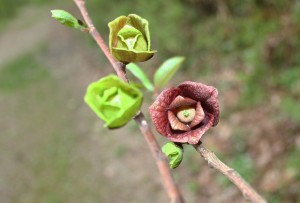
A big plus in favor of growing pawns: it practically does not suffer from diseases and pests.
Popular varieties
Martin, Overlis, Rebecca’s Gold, Azimina Dessert, Sochi 11.
soil
Drained, fertile. The plant is very fond of organic matter. Loves moisture, but does not tolerate stagnant water.
Place
Well lit or diffused light. Young plants need shade after planting. Dislikes Azimin and erasers.
Play landing
Reproducing the azimine is not an easy task.
The seeds of the plant are dense; they require mandatory stratification before planting. But even so, they can appear for a long time (often not in the first year).
There are other ways of plant propagation: root shoots and grafting.
Root shoots are rare and very few in number. Young shoots do not tolerate transplanting well; it takes them a long time to get stronger.
Plant care.
Azimin’s care provides for the standard: regular watering, log mulch, spring-summer top dressing (preferably 2-3, with an interval of two weeks) with complex fertilizer.
If necessary, pruning is carried out. It is best to do this in early spring, before sap flow.
When growing in open ground for the winter, plants (especially young ones) are best covered with non-woven material. The plant growing in a tub for the winter months must be transferred to the room.
The three-lobed leg in the United States is called “Pow-Pow”, “Nebraska Banana”, “Banana Tree”. These popular plant names are related to the shape of the paw fruit – they are elongated, but much smaller in size.
The main advantage of the three-lobed papaya is the wonderful fruits for which it is grown. The taste of its fruit is unusual: it really looks like bananas, but it is more delicate, and the pulp of the papaya fruit has a strong and very pleasant aroma.
I must say that papaya fruits seemed to me the most delicious of all that I have tried. And then one day, when a friend dealt with me with them, I really wanted this culture to be on my site.
Having accumulated many years of experience in breeding and growing this plant, I want to supplement the site posted on the site.
Papaya in nature and in the garden
The genus of azimines includes 8 species common in the United States. Of these, six species grow in Florida, one in Texas. And one of the most common types of papaya grows almost throughout the country up to the Canadian border: it is he who has the greatest interest for growing in our country. The botanical name for this common species is azimine three-bladed (Asimina triloba).
Three-lobed azimine (hereinafter azimine) is a small, slow-growing deciduous tree that lives on loose soils in river floodplains. According to literature data, this plant tolerates frosts down to -25 C.
In the area where my garden is located (Tuapse), there are no such severe frosts. But my friend, who lives near Krasnodar, in the harsh winter of 2005/2006, when the temperature dropped to -28 ° C, the flower buds on the trees froze (although the wood and growth buds were not damaged).
Reproduction of paw seeds
Azimine seeds are very large, like.
I decided that azimine seeds were needed because this plant is native to the subtropical and temperate zones.
Immediately after removing the fruit, I placed the azimine seeds in fertile, loose soil, planting them in separate seedling cups. Then he dug seed bowls in the raised areas of the garden, shallow.
In winter, he made sure that the water in the seed bowls did not stagnate.
In April, some of the azimine seeds began to germinate, and I began to plant seedlings in a permanent place.
In the spring, he carefully monitored the moisture content of the soil, not letting it dry out.
Since the soil on my site is heavy, loamy, before replanting seeds, I completely replaced it with woody humus (I took it from rotten logs of edible chestnut, which we have a lot in the forest).
He made planting pits for papayas of different sizes, placing them in partial shade and in full sun. I made the largest hole about 1 meter deep and about half a meter in diameter, about 20 buckets of humus went into it.
Development and care of azimine seedlings.
I had azimine seedlings from May to August, and out of 14 planted seeds there were 11. In the first year I did not feed the plants, but only watered the seedlings as needed. The growth of azimine seedlings for the first season ranges from 10 to 30 cm. In October, his leaves turned yellow and he took a shower; young trees have entered a state of dormancy.
The next spring, in April, the seedlings of the azimine began to deplete, and buds began to bloom on their tops. At this time, I fed young plants with nitrodiamophosomas (about 20 g per bucket of water), but I did not find any particular reaction to fertilization.
At the end of the summer, he fed the young legs and no longer fertilized them at this time of year.
Simultaneously with the germination of seedlings in winter plants, 2 more azimine seeds germinated, which did not germinate last year.
In the second year, the growth of pawpaw seedlings also ranged from 10 to 30 cm.
In the third year, the last papaya seed was grown, and the plants that sprouted in the first year grew from 20 to 40 cm.
It turned out that young shoots growing in the shade live worse than in the sun. Therefore, they had to be transplanted, to which they reacted very painfully – growth stopped for 1-2 years.
In the fourth year, lateral branches began to form at the azimine seedlings.
An interesting feature of the paw-tree is that its skeletal branches are formed strictly in one plane, that is. This is a classic palmette.
In the photo: a small paw in summer; papaya in autumn.
Due to the lack of free space in the garden, I left only three pawns and distributed the remaining seedlings.
As the azimine grew, over the years I started to increase the amount of fertilizer and the dose of fertilizer and just used them.
It turned out that azimine responds to feeding, especially nitrogen and phosphorus fertilizers.
Flowering and fruits of the azimine.
In the sixth year of growth on the tree, the pawns began to form fruit buds. They were the size of a match and became clearly visible after the leaf fell.
The following spring, azimine buds began to bloom in March, long before the leaf buds opened.
In April, flowers of an unusual shape and color blossomed: light brown, with 6 petals and a large number of stamens. Papaya flowers have a faint and very unpleasant odor, reminiscent of rotten meat. This smell attracts scavengers, which in our conditions are the main pollinators of paw flowers. And bees are not interested in azimine flowers at all.
Azimin can be pollinated with its own pollen, but pollination inside the flower itself is excluded. The fact is that in the azimine flower, the stigma of the pistil first ripens. After 1-2 days, pollen begins to fall from the anthers of the stamens, and at this time the pistil withers. This is why the first papaya flowers do not produce ovaries.
In the first year, only 3 flowers bloomed on the stalked tree, pollination did not occur.
The following year, one paw tree had about 100 flowers, and the other – about 70. In addition, their flowering lasted 3 weeks, which made it possible to cross-pollinate and pollinate the flowers with their own pollen.
Pawpaw flowers fall off, they are easy to pollinate – just connect a hard wire to a cotton wool and transfer pollen from one flower to another.
Despite pollination of azimine flowers with carrion, artificial pollination increases the percentage of fruit set. Even with artificial pollination, the ovaries give about 60 percent of the pollinated flowers, and about 80 percent of the resulting ovaries fall off; this is normal.
Papaya flowers are often visited, but their participation in pollination is unlikely: these beetles are attracted only by the pollen of the plant, which they gladly eat along with the stamens, but do not touch the ovary.
Immediately after pollination of the flowers, the ovary began to grow very actively. After a month and a half, the ovaries reached half of their final size.
With azimine fertility, from 2 to 8 fruits were formed (usually 2-3 fruits). There were also individual fruits, but they were few.
Some of the azimine colors reached a significant weight, so I had to place accessories under heavy branches.
In late August – early September, shortly before the ripening of the paws, they grew slightly and began to change color to lemon yellow.
Fully ripe fruits are bathed. And if they were damaged by a fall, then they deteriorate very quickly, after 3-4 hours at room temperature.
The undamaged ripe fruit of the paw was best felt immediately after falling from the tree, and the next day it tasted like burnt coffee …
I tried to take papaya fruit from the tree shortly before ripening. When they matured in bed, their juiciness was very low.
Interestingly, with azimine fertility, the fruits ripen at the same time. But fertility crumbles only after the last fruits ripen, so the first ripe fruits ripen on the tree. Therefore, it is necessary to regularly check the degree of ripeness of each fruit in azimine fruiting after the beginning of the discoloration of the fruit.
Ripe papaya peels off easily when touched, while unripe papaya sticks tightly.
In the photo: the ripening azimine of fertility; paw shooting paw
Use the papaya fruit immediately after ripening. His skin is very thin, translucent; Easily removable like a banana.
There is information in the literature that jam and compotes are made from papaya fruits. But I only used them fresh because of the small harvest.
It must be said that the yield of papaya is very low compared to many other fruits. Even on mature trees, yields vary from 25 to 40 kg of fruit per tree. But this disadvantage is compensated by the excellent taste of the fruit and the absolute persistence of this plant.
In 26 years of growing three-lobed papaya, I have not noticed any damage to my plants. And I have not heard from any of my acquaintances, who grew up as an azimine, that something is damaged.
Papaya selection
Azimin was introduced into the culture a little over 100 years ago, so there are few varieties.
In total, about 60 species of azimine are known. In different varieties, fruits differ in ripening period, size, size of seeds in fruits. Obviously, in the near future, breeders will eliminate such a disadvantage as low azimine productivity.
Now I grow in my garden five varieties (more precisely varieties) of azimines. Of these, I got two varieties at the Institute of Mountain Horticulture in Sochi, where papaya is grown in Russia. A papaya brand was bought in the market and its origin could not be established. Another type of papaya was obtained from Sukhumi, where papaya cultivation was carried out during the Soviet era. And another one grew out of my herd, which remained after the death of the inoculated papaya vaccine.
I must say that the taste of fruit in different varieties of papaya is very different from each other. The sweetest was the papaya from my flock, the vaccine that killed her. And the most unsweetened fruits of the Sochi varieties are papaya; but then they ripen later than others, which makes it possible to extend the period of consumption of fresh fruits.
At the end of August, the first fruits of papaya ripen on the tree that I received from near Sukhumi. They are sweet but fairly dry and rarely weigh more than 100g.
At the beginning of September, the fruits begin to ripen on a gingerbread tree, which I bought at the market, as well as on a tree grown from a rootstock. In these two varieties of the larger fruit azimine, the weight of the fruit reaches 200 g.
And finally, in October, the fruits ripen on the trees of the Sochi selection; it also weighs about 200 g. Below are the characteristics of these two types of paw.
Azimina Sochi-17 three-bladed – fruits up to 200 g, harmonious taste (but sweetness, in my opinion, a little), average yield.
Azimin “Dessert” three-bladed – in taste and size, the fruit practically does not differ from the previous variety. But it has very small seeds, which increases the volume of pulp in the fruit. Yield is average.
Papaya vaccine
I want to say a little about the papaya vaccination. In one of the articles I read that it is difficult to vaccinate azimine, I cannot agree with this. From my own experience, I can say that the azimine is no more difficult to plant than a pear.
I plant papaya at the beginning of sap flow (in March) with lignified cuttings of the shoot. I cut the stock and stock by 1-1,5 cm in length, the tapered stem is a wedge and inserted into the cutting of the stock. The cambial layers must coincide on at least one side.
I take the vaccine tightly with a polymer film and close it with a polymer cap on top to protect it from moisture.
Vaccination with azimine usually takes root after 2 weeks, as can be judged by the time the buds awaken in the scion. After that I take off my hat, but at first I do not completely reveal the place where the scion and rootstock accumulate (I only weaken the harness). After just a month and a half, when the vaccine has worked well, I completely remove the tourniquet.
Of the six azimine vaccines, five have taken root.
As a result of vaccination, I now have five varieties on three papaya trees: one tree has three varieties, and the rest of the trees have one variety.
Placing claws in the garden
To get the best azimine fruit, it is important to choose the most suitable place for planting the tree.
As for the optimal location of papaya in a personal plot: it seems to me that at least in the southern regions, the paw should be placed in partial shade.
In my garden, a papaya tree grows near the forest at the edge of the site, where the sun shines for about 4 hours a day.
Another papaya grows next to the tree that shades the papaya in the morning.
The third azimine tree grows between trellises with vines that protect it from the early morning and night sun. As a result, this tree stays in the sun for no more than 3 hours in the middle of the day, and it is he who has the best fruiting.
In the horticultural season of 2015, when September turned out to be dry and hot (daytime temperatures did not drop below + 30C), all the fruits were baked in the fresh air on a tree leg, which was in the sun for half a day. sunny side. And on the rest of the trees, the pawns did not suffer.
So far, the yield of my legs is low: it does not exceed 10 kg per tree. But I believe that over time, my trees will be able to produce more crops.
I think azimine deserves widespread distribution in personal plots, at least in the south of our country.
Dwarf forms of the banana plant can be grown at home. True, in this case, for cultivation, you will need to devote a rather large tub, because even a low-growing papaya can grow up to one and a half meters.
What a papaya tree looks like: photo and description
The banana tree (stem) is a genus of dicotyledonous flowering plants that belongs to the Annon family. Deciduous tree, reaching several meters under favorable conditions (at home, about 12 meters). Easily formed in dwarf form. It is a very ornamental plant with a wide pyramidal crown and beautiful smooth bark. Banana leaves are quite large (up to 30 cm long and 10 cm wide). Large fallen leaves of the paw are damaged by strong winds, which should be taken into account when growing on a balcony or in a garden.
Look at the photo, what kind of flowers the banana tree has: purple-red, monoecious, large (up to 4 cm in diameter):
The cup consists of three leaves, a corolla with six petals. Blooms in spring before leaves develop. Long bloom (about three weeks). It is a cross-pollinated plant. When growing a banana at home, artificial pollination with a soft brush or cotton wool is necessary.
Plants are native to the southern regions of the United States. Currently distributed in Spain, France and Italy, in the last century it was brought to Russia. The plant is very resistant to frost and even tolerates severe winters with frosts (down to -29 °). Flower buds tolerate spring frosts quite freely.
As you can see in the photo, banana fruits reach 12 cm in length and 5 cm in diameter, collected in fruits of eight or more pieces:
Under the thin skin of the banana fruit, there is a pulp rich in fructose and sucrose, with a very sweet taste and subtle pineapple and strawberry aromas. Fruits contain all the minerals that a person needs, which are found in tropical foods and bananas. The pulp of the fruit is whitish-yellow, with a consistency reminiscent of butter. With proper agricultural technology, the yield of this crop is high.
The fruits are covered with a thin green rind, which later turns yellowish. The inside of the fruit is sweet and light flesh with a peculiar strawberry and pineapple aroma. It tastes like both a banana and a mango. The fruits of the plant are harvested into fruits, each of which can be up to 9 pieces at a time.
Pay attention to the photo – the fruits of the azimine have some similarities with bananas in shape:
Similarities can be found in the composition of these plants, the main wealth of which is pectin, ascorbic acid and trace elements such as potassium, calcium, magnesium and iron. Each fruit is rich in nutrients. Fruits are consumed freshly harvested, they are also used to make jam, jam, jam.
In the middle of autumn, the leaves turn yellow and fall off, and new leaves grow in late spring, after flowering. Individual flowers appear in the axils of the leaves of past years, in March-May. Each flower contains several pistils, which explains the flower’s ability to form approximately 9 fruits. The flowers are bisexual, but not self-pollinating, so cross-pollination is necessary for fruiting (this requires two trees). Pollination occurs when the pollen turns brown and friable and the tips of the pistils turn green and sticky. The fruits ripen in 4 weeks: they contain 10-14 large brown-black seeds arranged in two rows.
Fruit is a valuable food product. In addition to its nutritional and medicinal properties, fruits contribute to the production of endorphins, the “hormone of joy”.
Different parts of the plant have certain medicinal properties. The seeds contain an azimine alkaloid, which is used in case of poisoning as an effective emetic to help remove toxins from the body. A decoction of young leaves is a good substitute for diuretics, and freshly squeezed juice has a wonderful anthelmintic effect. Fruit extract strengthens the immune system.
Thanks to its beautiful leaves and large flowers, the plant is very decorative. In a container, it grows well below its natural growth.
The scientific name of the genus comes from the name of this plant among the Indians “assimin”. Also, according to the description, papaya fruit is similar to papaya, which is why it is often called “American” papaya.
Introduced into the culture a little over 100 years ago, so there are few varieties. In total, about 60 of them are known, the fruits of which differ in ripening period, fruit size and seed size. The selection takes place not only in his homeland in the United States, but also in our country. At home, bananas are grown only in dwarf form.
Growing and caring for the azimine banana tree outdoors
Plants are grafted long before the start of fruiting, in the second or third year. Vaccination is almost the only way to propagate varietal plants.
When growing azimines in the open field, do not forget that this plant is photophilous, but in the first two years of life it requires a little shading from direct sunlight. Mature plants prefer full sun.
It develops slowly, but with an increase in daylight hours (up to 16 hours), the growth rate increases: in three months a young tree can grow up to 1,5 meters in height.
Watering is necessary from spring to autumn regularly, constantly keeping the soil moist; however, stagnant water should be avoided.
The plant has fleshy and brittle roots, so it is not transplanted, but rather recharged. Do this in the spring when the plant starts to grow. A deep pot is needed for good growth, as the tree has a large root system.
The soil should be light, fertile and slightly acidic (pH 5-7).
During active growth, when caring for a banana tree, plants are fed according to the following scheme (for example, take June, but this must be done every month): June 1 and 15 – manure; June 8 – water-soluble fertilizer “Kemira-Lux”; June 20 – straw or potato ash (scatter 1 teaspoon of ash over the soil surface and water); June 25 – pond mud (150-200 g per liter of water).
In winter, the plant begins a period of deep dormancy, during which it takes at least two weeks of cold and 160 days of fresh content.
Flowers and fruits are formed on last year’s shoots, so adult plants are pruned annually for replacement. In addition, before the start of growth, a sanitary cut of the tree is made.
Absolutely resistant to a wide variety of damage from diseases or pests. For preventive purposes, it is useful to water the plant with a weak solution of potassium permanganate 2-3 times per season.
Growing an azimine banana from seeds
Propagated by seeds and grafts. For good germination, seeds must be stratified at 0 ° -4 ° C for 90-120 days. Seeds germinate after 7 weeks; When planted in late autumn in the ground, seedlings can be expected in July next year. Young shoots have a sensitive root system, so they are not recommended for transplanting.
When growing azimines from seeds, plants usually begin to bloom and bear fruit after 4-8 years, depending on the quality of the seeds, varieties and conditions. The grafted tree can bloom in 2-3 years. Easily grafted by any method, like other deciduous shrubs.
Since the plant is tropical, it is better to stratify seeds in the temperature range from +5 to +7 degrees. Stratification is the process of keeping the seeds of a plant at a certain temperature so that they germinate faster, in addition, this manipulation allows it to increase its germination.
Before planting, the seeds must be soaked in water for five days. In this case, the water is changed daily. After five days, the seeds are planted in the soil to a depth of about three centimeters. The first shoots should appear a month after sowing. The seedlings grown in this way should not be disturbed and transplanted, because the plant has a very delicate root system that is easy to damage. Therefore, it is better for a tropical tree to immediately determine its “permanent residence” on the site.
Leaving is not difficult. The main thing is sufficient watering, since the plant is moisture-loving. As for food, in the first year of life there is no need for it at all. Next, you need to add nitrogen and phosphorus fertilizers to the soil. In addition, you need to loosen the root zone, but in no case dig, so as not to damage the root system.
Azimine banana varieties: three-bladed, three-bladed and others.
There are about six dozen varieties of papaya. Almost all of them were bred in countries such as Canada and the United States, which, however, is not surprising, because North America is for us the historical homeland of this exotic plant. Almost all varieties currently grown in Russia are of North American origin.
Dávis – the fruits of this variety are of sufficient quality; They have a pleasant yellow flesh and a sweet taste.
Martin – A distinctive feature of this variety is its high resistance to cold.
Three-bladed paw – deciduous tree. This is the most winter-hardy species of the Annonov family. The three-lobed Asian banana tree is the only fruit plant in the temperate zone, widespread up to the Great Lakes, and therefore it is of greater interest for cultivation in our country.
Overlook – This variety has characteristics similar to Davis.
Dessert papaya – medium-sized plant, mid-ripening fruits, weighing up to 270 grams. The yellow pulp of the fruit takes up to 95%, has a very pleasant soft taste.
Sochi domestic variety 11 – vigorous plant, fruits ripen early. The fruits of this variety are large in size; by weight, they can reach 350 grams. The pulp of the fruit is orange-yellow in color. Its aroma is very pleasant.
Pawpaw Triloba from the Anonic family, the rarest plant. The three-bladed azimine banana tree is native to the southern and eastern coasts of the United States. This deciduous tree with an unusually beautiful bark and a fairly wide pyramidal crown, with large leaves up to 30 cm long, can withstand severe frosts of 30 degrees. Flower buds are covered with a thin protective layer that protects them from the harmful effects of spring frost. The tree blooms with large hanging bells, up to 3-4 cm in diameter. The flowers are reddish or purple in color. Flowering begins even before the leaves open and lasts about three weeks.
The tree should be planted in an area protected from strong winds. The trunk of the tree is planted with grass. Feed a handful of urea during the spring months. In the summer, remember to apply any combination of fertilizers several times. Roll up the root collar in the spring will help the trunk with a bag of sugar, a piece of polypropylene. In winter, the tree is covered with spunbond, agrofibre.
How to grow a banana tree at home: caring for a dwarf azimine at home
Dwarf papaya – very short, 20-30 cm. Distributed from central Florida to southeast Georgia. It blooms from April to June with burgundy flowers 2 cm in diameter and fruits 3-4 cm long.
Dwarf varieties are intended for growing at home: they are less demanding on conditions and are resistant to diseases. Homemade banana reaches a small height of up to 1,5 m.
For planting, choose small pots with a diameter of about 10 cm. Long flower boxes can be used for several seeds, keeping a distance of about 15 cm between them. Before growing a banana tree at home, prepare a 4: 1 mixture of river sand and peat, no need to fertilize, make good drainage. Spread the seeds over the surface of the moistened substrate and push them apart strongly, without falling asleep from above, leaving access to light.
Cover the pots with aluminum foil and place in a bright place, out of direct sunlight. Air the pots every few days. When dry, spray the substrate with a spray bottle. When caring for a banana tree at home, avoid rinsing and rotting the soil. If mold appears, remove the affected area of the substrate and treat the entire surface with a solution of potassium permanganate.
When grown at home, seedlings will appear in about 2-3 months. After the emergence of seedlings, the plant will grow rapidly, after about a week, the seedlings need to be transplanted into the ground.
It grows quickly in comfortable and gentle conditions. When formed at home, 15-18 leaves usually begin to bloom and bear fruit.
